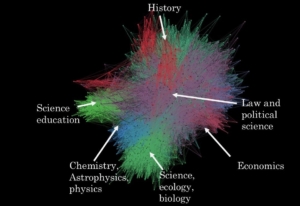Bluesky is emerging as the new platform for science
Scientific Twitter is about to find its true successor. And it is not X. This, our latest release, shows that the Bluesky network of scientists is growing — and growing.
The network of scientists on Bluesky has evolved significantly since our last update, now including 39,030 influential people in the scientific community, a 75 per cent increase over the 22,225 that my good colleague Lasse Hjorth Madsen and I released three months ago.
The total number of academics, researchers and science communicators on Bluesky will actually be much much larger, but this number: 39,030 is is a good estimate of the number of scientists who have a substantial scientist following within the scientific community itself. You can see how influential scientists make it on to our list here.

Lasse Hjorth Madsen (left) and I (right) are still enthusiastic about generating this model of the global scientific network
The growth that we see signals not only a broadening interest among scientists and science communicators for the platform. It also illustrates an increase in interconnections within the community.
No surprises here!
When you as a scientist move to a new professional social platform, you start to follow people. And it is likely the increase in these followings that also pushes the scientist numbers upwards in our model.
Mapping the big migration
With this update, we’ve incorporated timestamped data showing when each profile joined Bluesky, offering new insights into how scientists migrate across platforms.
Our top 100 list on Bluesky showcases a diverse range of scientists and science communicators on the platform who are particularly influential
A significant increase in sign-ups took place in August 2024, which may correlate with the wave of negative publicity surrounding the owner Elon Musk and the ban of X (formerly Twitter) in Brazil.

I have labelled some of the communities on this screenshot of the visualization here. Boundaries between research fields are decided by the algorithm. Some fields will be included in other communities.
More recently, the controversy over Elon Musk’s support of Trump in the US election has set off another wave of migration away from X.
Based on your feedback, we’ve revised our keyword set, expanding it to better capture diverse scientific fields. All scientific disciplines were also represented in the network’s structure in previous releases, but now we are even more certain.
Community boundaries between research fields are decided by the algorithm, and not by us. This means that important fields will in practice be included in other communities.
Within the network, different communities naturally form around certain interests. These clusters are algorithmically determined, and then labeled. However, these labels serve purely as a reflection of network structure and not as judgments on a field’s importance or size.
Just like on other social platforms, Bluesky has a skewed distribution of followers: A few individuals maintain sizable audiences, while most of us have smaller ones.
If a specific area of science isn’t labeled explicitly in our rendering, then it is likely because it is already well-integrated into a related community cluster.
New top 100 scientist influencers
Our top 100 list on Bluesky showcases a diverse range of scientists and science communicators on the platform who are particularly influential in terms of a measure called centrality. More on that here.
As for follower numbers. Just like on other social platforms, Bluesky has a skewed distribution of followers: A few individuals maintain sizable audiences, while most of us have smaller ones.

We meet up regularly in Copenhagen to square off the network analysis details
Since our last iteration, we have seen notable growth in a community labelled as ‘law, science and policy’. This suggests that interest in social science issues may be particularly resonant on Bluesky.
You can get an overview of our methods here.
Our method follows on from my own former TwiLi Index of recent years, which was an alternative measure of scientists’ ‘impact’, based on Twitter (now X) and LinkedIn following numbers.
New network visualization
Click and have a look at Lasse’s interactive visualization here.
We build our Bluesky network by doing this: We start off with a list of hand-picked members of the scientific community. Then we expand the network step-by-step, finding the scientists on Bluesky that they follow, and subtracting those that are not followed by a substantial number from the existing network.
We then use a key term search to subtract those that do not have a bio description that indicates an affiliation with the scientific community. Then we repeat the process again and again, until we are no longer getting substantial numbers of new scientists.
We compute centrality measures like ‘betweenness centrality’ and ‘PageRank’ to identify members that may be particularly influential.
Explore the network
We encourage you to play around with our network visualization tool, where each node represents an account and where the lines between them illustrate followings. The colours of the network are the distinct research communities which have a higher number of interconnections.
One final thing.
Our project aims to foster scientific collaboration and community, and is driven by the simple belief in the value of more meaningful connections.
We welcome your input as we refine our tools, and appreciate any comments or thoughts!
Does your department, faculty or university need to boost the international impact and career of your researchers? Here is more about my courses in social media for researchers. See other Mike Young Academy services here.



Trackbacks & Pingbacks
[…] Bluesky is emerging as the new platform for science. […]
Leave a Reply
Want to join the discussion?Feel free to contribute!